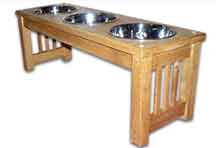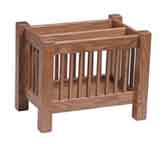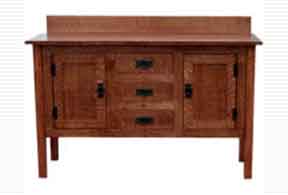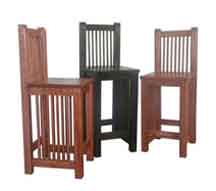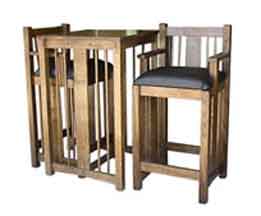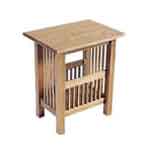
Most woodworkers start small, perhaps building a jewelry box, and in a sense Connie Slagle started that way, too. She built one for her mother, with the help of a neighbor, when she was six years old. After that, woodworking pretty much disappeared from her life until after she was married.
“At that point,” Connie recounted, “I did not have the money for new cabinets. Since it was cheaper to buy the lumber, I bought pine and remodeled my kitchen.” If fact, she remodeled it several times over the next seven or eight years, and I suppose that was what convinced her to do something most of us would regard as mildly insane for a person with absolutely no experience in the field. I’ll let her explain.
“Around 1986, I decided we needed a larger house,” Connie told me, “so I went out, marked off a spot, and, with nothing more than a shovel and wheelbarrow, started digging a basement. This time my husband helped, but both of us had full-time jobs. We worked in the evenings, and about a year later we had a new house. The basement of that house became my first shop.”
She made good use of it, and in turn, it nudged her into business. “Over the years, I built pieces for friends,” she explained, “including building a cradle for a friend’s new baby. When my daughter got pregnant in 1999, I called and asked if I could buy the cradle back, and she said flat-out no. That tipped me off to the fact that my work actually had some value.
“I quit my job and opened a business making and selling raised dog feeders and dog beds. I am really an animal person, and I wanted to test the water to see if I was good enough. That’s because I lacked the confidence to be a furniture maker. After all, when you make things for friends, they are always well received and it’s easy to get compliments.
“I listed my first dog feeder on eBay and was immediately blasted with orders. I created the Superior Feeders web site and, working alone out of my garage, started building and selling several Mission style oak feeders per day. A year later, I moved the shop into a converted pole barn that was on our property.
“I started by buying rough sawn, four quarter red oak lumber, but have since moved on to white oak. About 80 percent of my work is now in white oak. To be honest, though, I still only pay about two dollars a board foot even for flatsawn white oak, and about $2.40 a board foot for quartersawn white oak. I buy from a couple of sources that are so old-fashioned that neither will take credit cards. And, of course, I’m also a good negotiator.”
It was out of spite, though, that she got the courage to jump from furniture for dogs to furniture for people. “One day I went to the mill to buy oak,” she explained. “I wanted five boards, but the vendor made a joke about me buying the whole bunk, so to spite him, I bought the whole thing: 1,400 board feet. It was about 2,800 dollars. By the time I got home, I was horrified, thinking ‘What did I just do?’ I decided then and there that I needed to make something I could sell for more money than a $40 dog feeder.
“I started building Mission style end tables and magazine racks and selling them for $80 each on eBay, and orders just flowed in. Within a year, I opened the Mission Time Designs web site and started experimenting with making all sorts of other pieces. Almost immediately, I started getting calls asking for custom work.
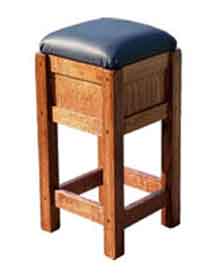
“To this day, I work alone and always have, and still make each piece one at a time. Of course, if I have two orders for the same thing at the same time I will make them together, but the fact that I primarily build one piece at a time means that custom orders are no more difficult for me than standard pieces. As a result, I do not charge extra for custom work. At this point, about 80 percent of my work is from custom orders.
“Over the years, I have made tables, chairs, stools, desks, entertainment centers, just about any furniture you would find in a house, for both people and their pets. However, about 45 percent of my work is making bar stools and frankly, I like doing them the best. I especially like designing them, in part because there are so many ways to do them and everyone’s interpretation is so different. I would make chairs all day long if I could.
“As sales increased, I started offering work to my son-in-law, who was a private contractor, and to other members of my family. I talked to customers, took orders, worked on the web site and built furniture with whatever time remained. Four other family members working in two other shops were also building to fill orders. In essence, the web site became the core of an extended family cottage industry making one-off furniture.
“Last year, I decided to focus specifically on quartersawn oak and solid cherry. I turned the Mission Time business over to my son-in-law and started Mission Oak Designs, going back to the ‘one-woman shop’ format. The primary difference is that Mission Time builds from flatsawn wood, but I build from quartersawn oak and cherry.”
Her love of Mission style stems, curiously enough, from literature and television, and from one place in particular. “Honestly,” she admits, “my love of Mission furniture and its style influence came from my adoration of Laura Ingalls Wilder’s ‘Little House on the Prairie.’ Those stories describe my ideal of life, and I’d love to be living in them.”
That “Little House” attitude influences her take on customer service as well, and results in her offering something few of us are lucky enough to enjoy outside of a boutique coffee shop.
“I believe that if you buy something, you should be able to talk to the person who made it. That’s my definition of customer service, and that is what I offer to my customers. They can talk to the actual person who crafted the wood on their furniture.”
I’ll drink to that.
